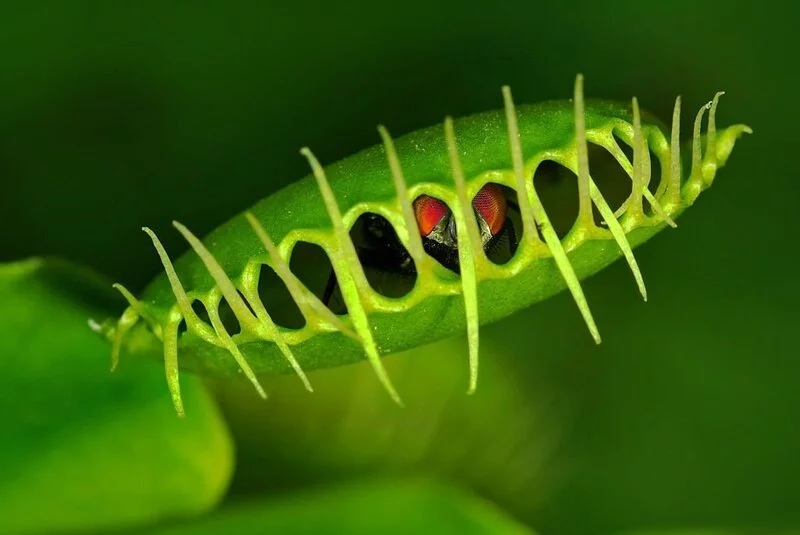The Venus flytrap, with its jaw-like leaves and carnivorous diet, is one of the most intriguing plants in the world. It’s a plant that has fascinated scientists and plant lovers alike for centuries, turning our traditional understanding of plants on its head. But have you ever wondered, amid all the excitement about its fly-catching abilities, how big does a Venus flytrap get? In this article, we will explore the size of these captivating plants, diving into the world of one of nature’s most extraordinary creations.
- REAL VENUS FLY TRAP PLANT: Large carnivorous plants that feed on bugs with jaw-like petals aka ‘bug traps’. This dionaea plant is a useful flying and non-flying insect trap, able to grow in a carnivore plant pot, carnivore plant terrarium, and more.
- FLY AND MOSQUITO TRAP: Functional house plants that trap and consume common bugs found in the home, such as flies, mosquitos, and spiders. Keep your carnivorous house plant thriving by planting it in a carnivorous plant pot with venus fly trap soil.
- DIY INDOOR TERRARIUM: Design a unique carnivorous plant terrarium with live flytraps and other terrarium plants. Real plants are also excellent for gift ideas. Create a Venus Fly Trap kit with Venus Flytrap soil, carnivorous plant food, and more.
- STRIKING PLANT DÉCOR: Showcase this stunning plant in a Venus Fly Trap pot with a carnivorous plant soil mix for an eye-catching display. Try planting your own Dionaea muscipula seeds in flytrap soil with Dionaea muscipula food to support growth.
- LIVE CARNIVOROUS PLANTS AT YOUR DOOR: Venus Fly Trap live plants (Dionaea Akai Ryu) will arrive fresh and in prime condition. These exotic plants can thrive as both live indoor plants or outdoor plants.
Venus Flytrap
The Venus flytrap, scientifically known as Dionaea muscipula, is native to the subtropical wetlands of the East Coast of the United States. Unlike most plants that rely solely on photosynthesis for food, Venus flytraps have adapted to thrive in nutrient-poor soil by catching and digesting insects. Each leaf on a Venus flytrap is divided into two regions: a broad, flat region capable of photosynthesis, and the famous “trap,” which has the ability to snap shut on prey. Understanding the Venus flytrap’s unique biology and growth habits is the first step in understanding how big these fascinating plants can get.
Size of Venus Flytrap’s Trap
The business end of a Venus flytrap, the part that sparks our imagination, is the trap. But how big does this insect-snatching marvel get? Well, despite what sci-fi movies might lead you to believe, the trap of a Venus flytrap is actually quite small. On average, the trap is only about 1 inch (2.5 cm) in length. It’s perfectly sized to capture small insects and spiders, providing the plant with a nutrient-rich meal that supplements its photosynthetic diet.
Overall Size of a Venus Flytrap Plant
Looking at the entire plant, Venus flytraps are relatively small in size. A typical mature Venus flytrap, from the base of the plant to the tip of the tallest trap, usually grows to a height of 5 to 6 inches (13 to 15 cm). In terms of width, a mature plant, with all its leaves spread out, might cover a circle about 4 to 5 inches (10 to 13 cm) in diameter. Despite their small stature, their extraordinary behavior and unique adaptations make them a gigantic topic of interest among plant enthusiasts and botanists.
Giant Varieties of Venus Flytraps
While most Venus flytraps are of the size described above, there are some “giant” varieties that grow larger than the standard ones. Cultivars like ‘B52’ and ‘DC XL’ are known for producing traps that can reach nearly 2 inches (5 cm) long. These larger varieties, when provided with optimal growing conditions, can reach a width of nearly 6 to 8 inches (15 to 20 cm) across. While still not enormous by general plant standards, these sizes are impressive for a Venus flytrap.
Factors Influencing the Growth of Venus Flytraps
Several factors influence the growth and ultimate size of Venus flytraps. The quality of their soil, light exposure, water quality, and even the number of insects they capture can affect their growth. It’s also important to note that, like many plants, Venus flytraps go through a dormancy period in winter. During this time, they will appear to shrink and lose many traps, but this is a normal part of their lifecycle.
- Solid Cube Gel: Unlike other liquid plant food, our Venus flytrap food is designed to mimic actual prey, providing a more natural and effective stimulation to the plant’s system. This solid gel closely resembles real prey, ensuring that your Venus flytrap receives the nutrients it needs in a way that encourages optimal growth and health.
- Dinner Time: Whether your carnivorous plants are not in a mood to hunt, or you lack the necessary food for it, you can always count on this solid gel food.
- Easy to Digest: Besides the necessary vitamins, and essential nutrients, this all-purpose plant food is mess-free and is the optimal solution for your Venus Fly Trap plant digestion.
- Versatile Food Item: Regardless of your plant, we got most carnivore plant covered. From Venus Flytrap and Sundew to Pitcher Plants, we developed this small Venus fly trap food suitable for every type.
- Instructions: Feed your plant with one cube weekly. If the plant is small, please cut the cube into smaller size. Apply the gel cube on plant’s feeding area
Conclusion
Venus flytraps might not reach the gargantuan sizes depicted in movies, but they hold a large presence in the plant world due to their unique insect-catching abilities. Whether they’re the standard variety or a larger cultivar, these plants, with their intricate traps, are an incredible demonstration of nature’s adaptability and innovation. Regardless of size, Venus flytraps continue to capture our fascination, proving that in the plant world, it’s not always about how big you are – sometimes it’s about what you can do.






